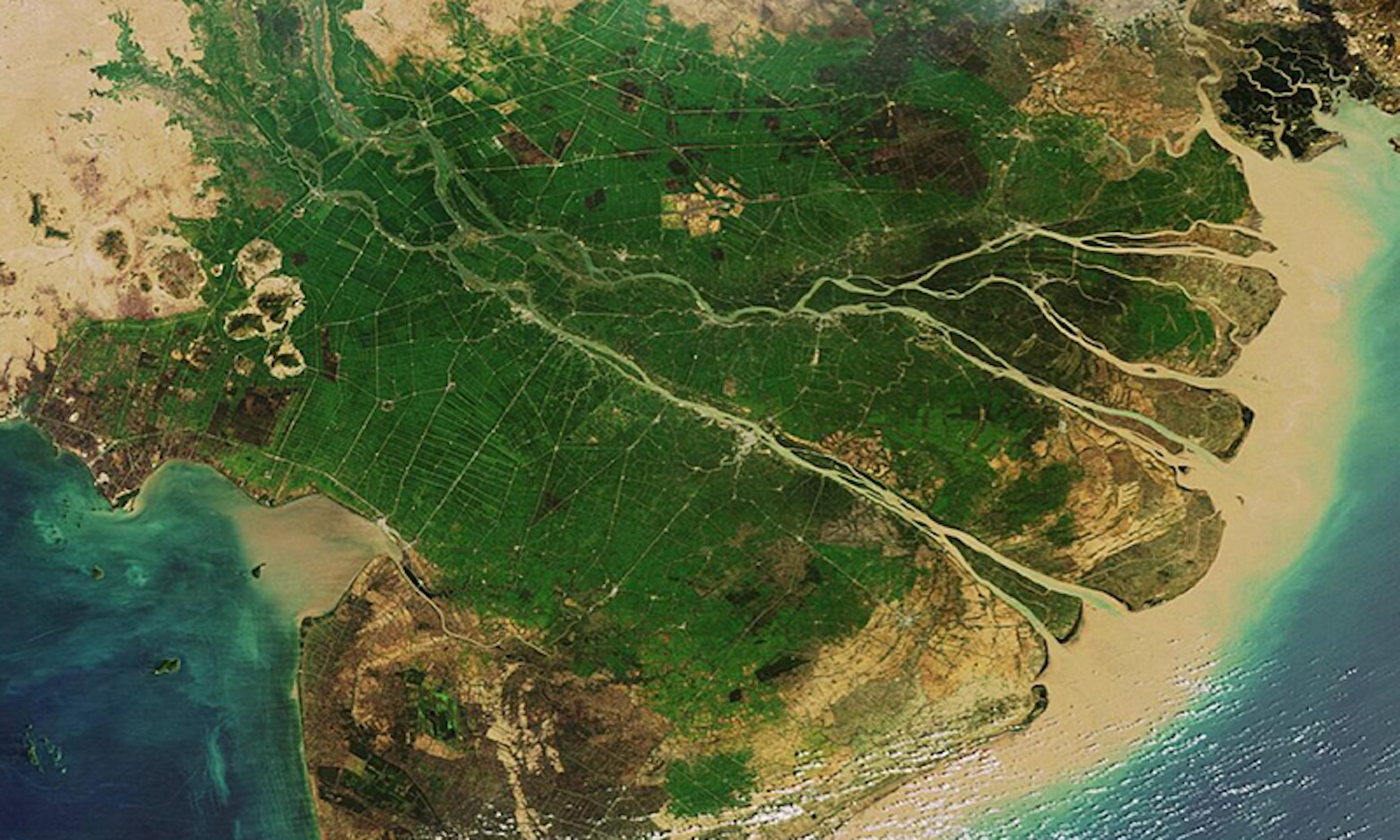Gazing out from the eighth floor of a hotel in Georgetown, Guyana, the broad expanse of the Atlantic Ocean was a muddy brown. Only a thin rim of blue on the horizon showed the ocean’s true color; the rest swirled with sediment emerging from the mouth of the Essequibo River.
In a rhythm that’s pulsed through epochs, a river’s plume carries sediment and nutrients from the continental interior into the ocean, a major exchange of resources from land to sea. More than 6,000 rivers worldwide surge freshwater into oceans, delivering nutrients, including nitrogen and phosphorus, that feed phytoplankton, generating a bloom of life that in turn feeds progressively larger creatures. They may even influence ocean currents in ways researchers are just starting to understand. But today, in rivers around the world, humans are altering this critical phenomenon.
In many places, the great culprit is the dam: a wall of concrete and stone bisecting a river, diverting its energy and water to human use. There are 58,000 “big dams”—50 feet high or taller—around the globe, with another 3,700 more planned, mostly in lower-income countries in Asia and South America.
Rising seas deservedly get headlines, but sinking land is an equally grave problem.
Many of the harms caused by dams are well-documented. They block fish passage and starve subsistence fishers; radically alter natural river regimes and aquatic creatures’ lifecycles; and flood forests, wetlands, villages, and historical sites. (They’re also less climate-friendly1 and reliable2 than is widely believed.) Now scientists are describing another impact that has received relatively little attention but appears to also be profound: Dams block sediment-carrying river pulses into the ocean.
Researchers used satellite data to estimate sediment changes over the past 40 years in 414 rivers around the world and found that dams in the global north—North America, Europe, and Asia—blocked 49 percent of sediment delivery to coasts.3 That finding, which was published last year in the journal Science, is even more striking when considering the frenzy of dam-building that occurred during the 1970s. The study’s early 1980s baseline likely already showed a significant departure from the rivers’ natural states.
“Humans have built structures that have drastically outstripped the impacts of climate change in many ways,” says Evan Dethier, an oceanographer at Bowdoin College and the study’s lead author.
Sediment plays vital roles in river and coastal systems. When rivers overflow onto their floodplains, water slows, dropping silt that shapes its flows and nourishes vegetation growing amidst the channels. The sediment also brings nutrients to the floodplain, helping to jumpstart algae blooms that in turn feed phytoplankton and juvenile fish. At the sea’s edge, sediment continually rebuilds coastal land otherwise eroded by ocean waves. Rising seas deservedly get headlines, but sinking land is an equally grave problem for people living in river deltas now starved of sediment.4
The stories of rivers and the sediment they carry don’t end there. The ocean is turbulent, which can cause its currents to meander back and forth, like streams do on land. Meanders become unstable, forming eddies, where strong currents meet weak ones, and where freshwater meets denser, often colder, saltwater. When rivers enter oceans, they form a plume of freshwater that can extend 80 miles offshore; the resulting collision of freshwater and saltwater, their differences in temperature, and the sediment they carry, generate eddy trains, like a conga line of eddies, which impact larger ocean circulation patterns.

Researchers led by Annalisa Bracco, an oceanographer at the Georgia Institute of Technology, investigated these dynamics in a study of the plume created by the Mekong River, the 12th-longest river in the world.5 It flows nearly 3,000 miles from its headwaters in the Tibetan Plateau through China, Myanmar, Thailand, Laos, Cambodia, and Vietnam before reaching the South China Sea.
More than 150 dams have been built in the Mekong River basin, including 13 on the river’s mainstem, and more than 100 additional dams are planned. To understand how they may affect the South China Sea, Bracco’s team created a computational model of the Mekong plume’s effects on the sea’s circulation today. Then they simulated how the plume will behave if more dams are built, dramatically reducing the Mekong’s annual mean flow and its seasonal cycle.
“You really get a different transport,” Bracco says. Because freshwater is less dense than saltwater, water from the plume tends to remain at the surface, where it is more easily moved by wind. If the Mekong’s plume is diminished, winds will need more energy to move seawater, slowing the velocity of currents, she says.
Bracco’s team found that, in the South China Sea, summer monsoon winds drive currents northeast, carrying nutrients, food, and warmer temperatures with them. Future dams would make the eddy train falter, weakening the movement of northward currents and decreasing the marine ecosystem’s productivity.
Bracco recounts a time when she was on a boat, measuring ecosystem changes along the river plume. “You see the plankton that emerges and blooms following the impact of the river water,” she says. That, in turn, feeds larger species. “If you change the river drastically and it’s not bringing in the plume anymore, you prevent the ecosystem from having that bloom.”
Dams are less climate-friendly and reliable than is widely believed.
Glen Gawarkiewicz, a physical oceanographer at Woods Hole Oceanographic Institution who studies the Northwest Atlantic, notes that eddy trains carry sediments from river plumes across continental shelves into ocean basins, and fish concentrate at these nutrient fronts. “Reduced eddies could mean fewer nutrients getting into ocean basins. And in Southeast Asia, fish are very important for protein, and culturally,” Gawarkiewicz says. Fishing in the South China Sea already sparks diplomatic controversies, he says, and changes in nutrient circulation may trigger new conflicts.
While Bracco’s findings about the likely decline of ocean productivity in the South China Sea are sobering, she cautions that the dynamics she observed are not universal. “There’s nothing that happens in the same way everywhere,” she says. For example, the Mississippi River’s plume is not changing the direction of currents in the Gulf of Mexico. “The Loop Current, which is the main oceanic current into the Gulf of Mexico, is just so big and so strong.” (Of course, the Mississippi plume has another well-documented impact: Nutrient overload from agricultural runoff creates a vast dead zone every year.)
Nevertheless, it’s difficult to accurately assess wider impacts because today’s climate models—the only tools available for predicting Earth system behaviors decades into the future—are too low-resolution to accurately show the effect of river plumes. The oceanic turbulence Bracco tracked in the South China Sea, which influences the structure of eddies and currents, occurs on a scale of one to two kilometers. Most climate models have a resolution of 50 to 100 kilometers. At that coarse resolution, turbulence from river plumes doesn’t register. When existing models attempt to account for freshwater delivery from major rivers, they “mix that water in a way that’s very different from reality,” says Bracco.
Gawarkiewicz notes a related issue. In his own studies of how freshwater gets into the deep ocean, he’s found that “there are lots of surprises to it. The dynamics are very complicated.” Interactions among wind and water, tidal mixing, the presence and intensity of sunshine, and eddy motions all affect what happens. But climate models generally use just one variable—the density difference between the fresh river plume and the salty sea—to stand in for all these factors.
Human-induced changes in the quantity, quality, and timing of river plumes may have other still-unpredictable impacts on the ocean. Building dams isn’t the only way that humans are changing river plumes. Rather than holding back sediment, sometimes people cause vast amounts of excess sediment to be released.
The study documenting the dramatic reduction in sediment delivery to coasts in the global north found the opposite problem in the global south. Coasts in South America, Africa, and Oceania now receive 36 percent more sediment than they did four decades ago, largely because of runoff and erosion caused by deforestation to make way for palm oil, soy, sugarcane, and mining.
During the past decade, the Gulf of Mexico and the Caribbean Sea have experienced a troublesome explosion of sargassum seaweed; Bracco thinks it will ultimately prove related to deforestation-induced runoff bringing excess sediment into the Amazon River’s plume.
Most ocean impacts caused by human changes to river plumes are likely local, says Bracco, rather than global. But with dams already blocking two-thirds of large rivers worldwide and thousands more planned, those local impacts could affect ocean life just about everywhere—and we’re only beginning to reckon with them. ![]()
Lead image: The Mekong River Delta in Vietnam. Credit: The European Space Agency.
References
1. Fearnside, P.M. & Pueyo, S. Greenhouse-gas emissions from tropical dams. Nature Climate Change 2, 382-384 (2012).
2. Gies, E. Can wind and solar fuel Africa’s future? Nature 539, 20-22 (2016).
3. Dethier, E.N., Renshaw, C.E., & Magilligan, F.J. Rapid changes to global river suspended sediment flux by humans. Science 376, 1447-1452 (2022).
4. The One Earth Editorial Team. Keeping pace with changing deltas. One Earth 6, 183-184 (2023).
5. Zeng, X., Bracco, A., & Tagklis, F. Dynamical impact of the Mekong River plume in the South China Sea. JGR Oceans 127, e2021JC017572 (2022).


































